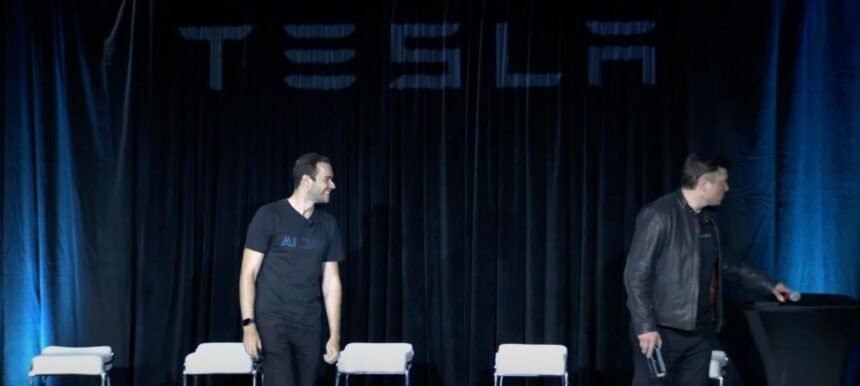Tesla’s former head of artificial intelligence, Andrej Karpathy, who played a crucial role in the automaker’s self-driving endeavors until 2022, has issued a cautionary message against prematurely believing that self-driving technology is fully solved and that autonomous vehicles are just around the corner.
Karpathy, a highly esteemed figure in the field of artificial intelligence, was recruited by Elon Musk from OpenAI in 2017 to spearhead Tesla’s AI initiatives, including the development of neural networks for Autopilot and Full Self-Driving capabilities. After parting ways with Tesla in 2022, he briefly rejoined OpenAI in 2023 before founding his own AI education company, Eureka Labs.
As a Slovak-Canadian computer scientist renowned for his expertise in computer vision, Karpathy is credited with championing Tesla’s vision-only approach to self-driving technology. Recently, he delivered a talk at Y Combinator’s AI Startup School event, shedding light on the complexities of achieving true autonomy in self-driving vehicles.
Reflecting on a ride he took in a self-driving car back in 2013, Karpathy recounted a flawless 30-minute drive around Palo Alto, which left him convinced that self-driving technology was on the brink of a breakthrough. However, fast forward 12 years, he emphasized that despite significant advancements, the challenge of achieving full autonomy persists.
While Waymo currently operates a fleet of over 1,000 autonomous vehicles conducting hundreds of thousands of rides each week, Karpathy cautioned against assuming that autonomy has been definitively achieved. He highlighted the continued involvement of human operators in Waymo’s vehicles, indicating that the technology still relies on human oversight to navigate complex scenarios.
Karpathy underscored the intricate nature of software development, stressing that the evolution of AI agents capable of performing complex tasks like driving will require time and ongoing refinement. He expressed confidence that autonomous technology will ultimately succeed but cautioned that the journey towards fully autonomous systems is likely to span a decade rather than a single year.
In light of Karpathy’s insights, it becomes evident that the road to achieving truly autonomous vehicles is paved with challenges and complexities that demand meticulous attention to detail and continuous innovation. As Tesla prepares to launch its “Robotaxi” service, the scrutiny surrounding self-driving technology intensifies, prompting a critical examination of the industry’s progress towards achieving genuine autonomy.
While Karpathy refrained from explicitly mentioning Tesla in his remarks, his observations align with recent developments in the self-driving space. With Tesla’s Robotaxi launch incorporating human supervision and safety measures akin to Waymo’s operations, the path to fully autonomous vehicles appears to be a journey that necessitates incremental progress and a steadfast commitment to safety and reliability.
As the industry navigates the evolving landscape of self-driving technology, Karpathy’s insights serve as a reminder of the complexities inherent in achieving true autonomy and the importance of embracing a long-term perspective in the pursuit of safer and more efficient transportation solutions. Over the past few years, the world has seen a significant increase in the number of natural disasters occurring around the globe. From wildfires and hurricanes to floods and earthquakes, these catastrophic events have caused immense damage to both property and human life.
One of the most devastating natural disasters in recent memory was the 2019-2020 Australian bushfire season. The fires, which raged across the continent for months, destroyed millions of acres of land, killed an estimated 3 billion animals, and claimed the lives of at least 34 people. The fires were fueled by a combination of record-breaking temperatures, prolonged drought, and strong winds, creating the perfect conditions for the blazes to spread rapidly and uncontrollably.
In addition to the immediate destruction caused by the fires, the long-term effects have been equally devastating. The loss of habitat for countless species of wildlife has had a profound impact on ecosystems across Australia, with some species facing the threat of extinction as a result. The fires also released massive amounts of carbon dioxide into the atmosphere, contributing to climate change and further exacerbating the global environmental crisis.
The Australian bushfire season serves as a stark reminder of the urgent need for action to mitigate the effects of climate change and prevent future natural disasters from reaching such catastrophic levels. Governments and organizations around the world must work together to implement policies and practices that reduce greenhouse gas emissions, protect vulnerable ecosystems, and build resilience in the face of extreme weather events.
In the aftermath of the bushfires, many communities in Australia have come together to support one another and begin the process of rebuilding and recovery. Volunteers from around the country have donated their time and resources to help those affected by the fires, while organizations have launched fundraising campaigns to provide aid to those in need.
While the road to recovery may be long and challenging, the resilience and spirit of the Australian people give hope for a brighter future. By working together and taking proactive measures to address the root causes of natural disasters, we can create a more sustainable and resilient world for future generations.







